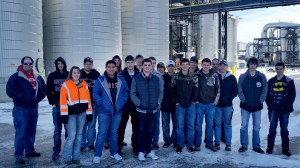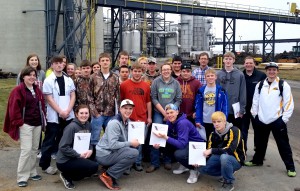More than 40 Minnesota high school students from Arlington’s Sibley East High School and Norwood Young America’s Central High School have visited Heartland Corn Products to learn more about ethanol production. Heartland Corn Products is one of the largest ethanol plants in Minnesota with an output of 108 million gallons a year and was built in 1995. During the tours, students learned about different elements of production including grain grading and handling, fermentation, grain storage, liquefaction and ethanol storage and shipment.
“We were interested in the tour so we can learn about this renewable energy source that is so important to Minnesota’s agriculture economy,” said Jim Mesik, agriculture teacher at Central High School. Minnesota is the fourth largest ethanol producing state.
Included in the tours was dried distiller grain production and storage. Dried distiller’s grains (DDGs) are a high-protein animal feed. In 2015, Minnesota’s ethanol industry produced 3.6 million tons of DDGs, which was sufficient to meet the feed requirements of the entire inventory of cattle and calves in the state.
“We are always pleased to welcome high school students to our plant and provide them with a first-hand look at how clean Minnesota-grown renewable energy is produced,” said Scott Blumhoeffer, Vice-President at Heartland Corn Products.
“These tours show students how a homegrown renewable ingredient is converted into a clean fuel that continues to reduce harmful greenhouse gases. These tours also provide them with a better understanding of the career opportunities in Minnesota’s ethanol industry,” said Tim Rudnicki, executive director of the Minnesota Bio-Fuels Association, whose organization organized the tours.
Sibley East High School’s agriculture science teacher, Jeff Eppen, said it was important for students to get a better understanding of the ethanol industry and how it is produced, adding some of the school’s former students have been employed at Heartland Corn Products.
“A unique part about agricultural education is the instructor, students and community help decide the curriculum for their school. We as a school have decided that we want biofuels as a part of our Ag education,” he added.



